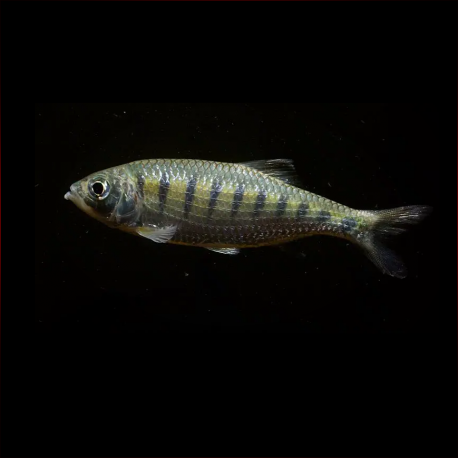More info
Datasheet
| Minimum Tank Size | 540 litres / 142.65 US gallons |
| Maximum Size | 13.0cm / 5.12inches |
| Temperature | 16°C / 60.80°F - 24°C / 75.20°F |
| Hardness | 2.02dgH / 36ppm - 15.02dgH / 268ppm |
| pH | 6.0-8.0 |
General Description
Opsarius Barna, commonly known as the 'striped hill trout' or 'banded hill trout', is a species occasionally found in the ornamental trade. It can be identified by its 16 predorsal scales, complete lateral line with 40-42 scales, absence of barbels, and 9-11 dark blue vertical bars on its body. The generic classification of Opsarius has been a topic of debate among researchers, with different lineages identified within the Barilius grouping.
Aquarium Setup
For housing Opsarius Barna, a tank setup mimicking a flowing stream is ideal. Utilize a substrate of rocks, sand, fine gravel, and water-worn boulders, along with driftwood roots and branches for decor. While most aquatic plants struggle in this environment, hardy species like Microsorum, Bolbitis, or Anubias can be attached to decor. The species requires spotless water, high oxygen levels, and moderate water movement, necessitating the use of external filters, powerheads, and airstones. Regular water changes and a securely fitted cover are crucial due to their jumping tendencies.
Behaviour
Opsarius Barna is unsuitable for community tanks due to its specific environmental needs and vigorous feeding behavior. As a fast swimmer and proficient feeder, it may intimidate or outcompete slower or smaller species. This species tends to be aggressive towards similar-looking fish, thereby should be housed with similarly-sized, robust cyprinids such as Dawkinsia, Barilius, or larger Devario and Rasbora species. It is a shoaling species that requires a group of at least five individuals to prevent bullying among subdominant fish.
Feeding and Diet
In the wild, Opsarius Barna primarily feeds on aquatic and terrestrial insects, supplementing its diet with small fishes and benthic invertebrates. In captivity, they accept high-quality dried foods but should also be offered live or frozen fare like chironomid larvae, Artemia, chopped earthworms, fruit flies, and small gut-loaded crickets.
Reproduction & Dimorphism
Limited information is available on the reproductive habits of Opsarius Barna. However, it is suggested that large, cool water changes can stimulate spawning. Sexual dimorphism is noticeable in adult females, who are typically less brightly colored, larger, and thicker-bodied than males, especially when gravid.
Habitat and Distribution
Opsarius Barna is typically found in well-oxygenated, fast-flowing rivers and streams with substrates of gravel, cobbles, and boulders. Indigenous to the Ganges and Brahmaputra river basins in northern India, it may also inhabit river systems in Nepal, Bhutan, Bangladesh, and Myanmar. The species has been recorded in various habitats alongside a diverse array of fish species.

